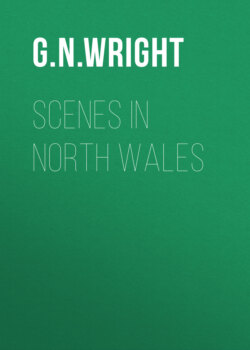Читать книгу Scenes in North Wales - G. N. Wright - Страница 9
На сайте Литреса книга снята с продажи.
CAERNARVON CASTLE.
ОглавлениеTable of Contents
Caernarvon is an ancient borough town, a favourite watering place, and enjoys the benefit of a considerable export trade in slates of the best quality, besides the supply of the interior with wines, coal, earthenware, &c. It is surrounded by walls, the space enclosed resembling the form of a harp, the royal castle being the head or termination of the upright arm, and a fine, broad, marine terrace outside it, now constitutes the chief promenade of inhabitants and visiters. The local position of Caernarvon is extremely beautiful—the town walls, and long terrace are washed by the sea in front; the river Seiont flows round the castle walls, and meets the waters of the Mænai beneath its lofty turrets, while Coed-Helen Mount impends over the town on the south, Twt-Hill on the North, and Moel Eilio and the Snowdonian range cross and terminate the distant view. There is a striking similitude between the natural position of Algiers and that of the town of Caernarvon, as seen from the water. Twt Hill corresponds with the Jewish cemetery; there is a mount also hanging over Algiers on the right, and the terrace of Caernarvon is an exact miniature of the famous thousand-gun battery of the Turkish city, though happily deficient in such a supply of dread artillery.
The name Caernarfon is compounded of the British terms Caer yn ar-ffon, or Mon, the citadel in Arfon, or in the district opposite to Mon (Anglesea). It was the ancient Segontium of the Romans, and was the only post of consequence in this part of Cambria over which the imperial eagle flapped his wings. Some fragments of a Roman wall are still distinguishable near the town, and outposts, roads, and encampments yet survive in the immediate vicinity.
Upon the final subjugation of the ancient Britons, in the year 1282, King Edward the First commenced the building of a noble castle at Caernarvon. This he designed for his royal palace; and mixing up some soothing artifices with the vigorous measures of a conquering prince, caused his faithful and much beloved queen to be brought hither, at an interesting moment of her life, where she gave birth to Edward, afterwards sirnamed Caernarvon. This was the second wily stratagem practised upon the obstinate Welshmen by King Edward. His first attempt to render their fetters less galling, was made by assimilating the form of the fortifications of Conway and Caernarvon, which were actually species of state prisons, to the likeness and disposition of the arms of a harp.
Caernarvon is the largest of Edward’s castles, and is probably still the most entire; the river Seiont and the Mænai strait washed the walls on two sides, and a deep fosse, originally crossed by a drawbridge, completed the watery circuit. The entrance possesses an air of much grandeur. It is a lofty pointed arch, defended by noble flanking towers, and adorned with a colossal figure of the conqueror himself, standing in a canopied niche, in the act of unsheathing his sword. The interior, which is represented in the accompanying view, is much more ruined. The apartments for the accommodation of the garrison are quite buried in rubbish. Of the entrance gates, a fine ribbed archway, with the grooves of four successive portcullises, are still distinct; the mural gallery is complete nearly round the whole circuit of the castle, and the outer walls of the royal apartments, with the enriched mullions of the windows, yet unbroken. From the walls of the great western towers, light delicate turrets, of polygonal forms, appear to spring; one of these is accessible by stone stairs to the summit, which is adorned with the figure of an eagle, said to have been brought hither from Segontium by the Saxon king, but more probably a species of ornament suggested to the founder by the proximity of the Roman citadel, and intended to be complimentary to the inhabitants. From the observatory, on the top of the eagle tower, there is an extensive prospect over the Island of Anglesea, the Bay of Caernarvon, and the low lands along the base of the mountains, but it is wholly commanded by the hills on either side of the town.
The graceful archway, called Queen Eleanor’s gate, does not appear to have been a portal of entrance. From this a platform may have been lowered, on which the queen mother appeared holding forth her royal infant towards the assembled chieftains, and, after the performance of this great mockery, restored to its secure fastenings in the wall; but no satisfactory evidence appears of any entrance doors, except the chief one mentioned previously, and the water-gate at the western end of the castle. The Newborough, Bulkeley, and Mostyn families have successively been vested with the government of the town and constableship of the castle, cares now entrusted to the Marquis of Anglesea.
The town walls are still perfect, and interesting to the antiquary. A handsome assembly room has been fitted up within the towers of the principal gate, at the expense of Sir Watkyn W. Wynne, Bart. An elegant chapel of ease occupies the northern angle of the walls, and includes one of the large rounders; and a beautiful barbacan, in advance of the water-gate, is in the most entire preservation. Caernarvon is situated in the parish of Llanbeblig, and the parish church, an ancient edifice, dedicated to Saint Publicius, stands at the distance of about one mile from the castle.
